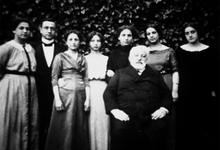- Images (2)
- Links (0)
- Agenda (0)

|

|

|

|

|
by Barbara METER
2000 / 16mm / b&w / sound / 1 screen / 18' 00 |
Meter works with still photographs of Weimar-era Germany that were left to her by her parents, who fled the country in 1934.
In this film, Meter listens to found images that never produced any sound. She writes: ‘Independently of each other, my father and my mother fled from Germany in 1934. They met the same year in Amsterdam. This film is made from photographs they left me, all of which were taken before I was born.’ Through slow, hand-held movements of the camera, fades, and dissolves by the artist, the collage of images becomes a journey through the Weimar Republic of the 1920s and 1930s, a time when the government organized the railroad system, and of Hitler’s Germany. Meter explains: ‘This film hesitates between photography and film: static yet in motion, the portraits seem as if between life and death.’ The closer Meter gets to these portraits with her lenses, the more inscrutable they become. The music transitions in this film go through what seems to be an intermediate state of dubitative silence, only to be interrupted by sound effects of strangers’ voices played backwards, German radio, magpies’ calls, and a continuous undercurrent, flapping, pounding beat. With sounds of that era, Johann Sebastian Bach, and Marlene Dietrich, Meter takes these images from their native dark period to try to understand them and reflect this darkness back. The book ‘Letters to Barbara’ (Gertraud Middlehauve Verlag, 1988; translated to English by James Agee, The Overlook Press, 1995) is a compendium of the scanned letters and drawings that Leo Meter, the artist’s father, sent her when she was a child, once he was separated from his family and recruited by the Germans as a soldier. He died at age 35. These letters, and the memories they provoke, have served of inspiration to several of Meter’s films.
- Mónica Savirón
«Barbara Meter's APPEARANCES traverses the distances from the uncanny (unheimlich) to the warmth of the familial, and draws the particular - people and relationships - from the background of life of Germany during the first half of the twentieth century.
The film consists in large part of re-filmed photographs, together with passages in which the reality in front of the camera is filmed directly (although the photographs are themselves part of both material and other realities, of course). Repeated darkenings and lightnenings of the background tone of the film (and this is a film in which atmosphere and emotional tone are central) are achieved through the use of subtle camera movement in re-filming portrait and family photographs; through light revealing form in them in a way which is normally only possible when filming people or solid objects; and through sound-images pairings making use of music with strong associations, and of other sounds (...)».
- Nick Collins.
| distribution format | 16mm |
|---|---|
| screen | 1,37 (single screen) |
| speed | 24 fps |
| sound | optical sound |
| rental fee | 61,00 € |